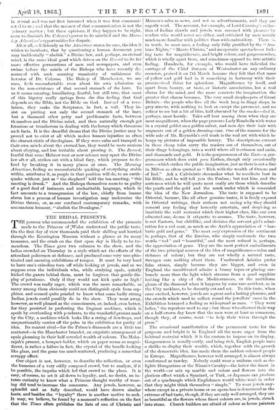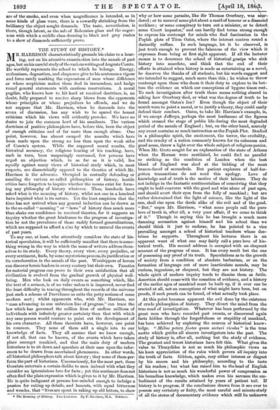THE BRIDAL PRESENTS.
THE persons who recommended the exhibition of the presents made to the Princess of '„Wales understood the public taste. On the first day of view thousands paid their shilling and hurried through the Kensington Museum without a glance at its many treasures, and the crush on the first open day is likely to be tre- mendous. The Times gave two columns to the show, and the ladies crowded on Thursday in a style which set the efforts of the attendant policemen at defiance, and produced some very unsophis- ticated and amusing exhibitions of temper. It must be very hard to have one's crinoline torn off while looking at jewels, and so we suppose even the individuals who, while studying opals, quietly kicked the gazers behind them, must be forgiven that gentle dis- play of petulance. Only if they would not kick quite so high ! The crowd was really eager, which was the more remarkable, as many among them obviously could not distinguish opals from sap- phires, and seemed quite puzzled to know what some badly strung Indian jewels could possibly do in the show. They went away, however, as well •pleased as the connoisseurs, or, indeed, even better, for they persisted in preferring the Dagmar necklace, which is spoilt by overloading with pendants, to the wonderful present made by the City, a necklace which looks like a string of dewdrops, and unquestionably carries off the palm in the exhibition for purity of idea. Its nearest rival—for the Prince's diamonds are a little too scattered—is the Manchester bracelet, an exquisite arrangement of opals gleaming in their half revealed wealth of colours. The Maha- rajah's-present, a bouquet-holder, which on paper seems so magni- ficent, is rather a failure in fact, the crystal of the handle looking like glass, and the gems too much scattered, producing a somewhat scrappy effect.
Our-object is not, however, to describe the collection, or even the humours of a very oddly composed crowd, but to analyze, if it be possible, the impulse which led that crowd to the place. It is easy, of course, to set it all down to loyalty, and, no doubt, an in- tense curiosity to know what a Princess thought worthy of wear- ing did- tend to increase the concourse. Any jewels, however, as splendid and as fully described, would have drawn similar hosts, and besides the " loyalty" there is another motive to seek. It may, we believe, be found'by a moment's reflection on the fact that the Times often publishes the lists of one of Christie and Manson's sales as news, and not as advertisements, and they are eagerly read. The account, for example, of Lord Canning's collec- tion of Indian shawls and jewels was scanned with pleasure by readers who would never see either, and criticized by men usually much more familiar with politics than with embroidery. 'There is, in truth, in most men, a feeling only fully gratified by the " Ara- bian Nights," "Monte Christo," and an operatic spectacle—a lurk- ing taste for magnificence, and bright colour, and gorgeous robes, which is wholly apart from, and sometimes opposed to, true artistic feeling. Hundreds, for example, who would have ridiculed the carriage of the Chief Burgess of Westminster on any ordinary occasion, praised it on 7th March because they felt that that maw. of yellow and gold had in it something in harmony with their preconceived thirst for splendour. Magnificence by itself, and apart from beauty, or taste, or historic associations, haa a real charm for the mind, and the more concrete the imagination the greater that charm becomes. The very small shopkeepers of Great Britain—the people who live all the week long in dingy shops, in grey streets, with nothing to look at except the pavement, and no colour to see but a bit of blue, half obscured by the smoke—feel it, perhaps, most keenly. Tales sell best among them when they are • most magnificent, when the page presents Lady Rosabella with water in a crystal goblet on a golden salver, and men dye their hair with unguents out of a golden dressing-case. One of the reasons for the- wide sale of 'al r. Reynolds's evil trash is the real art with which he- heaps up pictures of impossible luxury. The descriptions current in these cheap tales carry the readers out of themselves, out of their dingy belongings, into a world where all is crimson and satin, and diamonds and gold. It is the gorgeousness of the East—a gor- geousness which does exist pace Eothen, though only occasionally seen—which strikes the public imagination, just as there is not a line in Milton so often quoted as " Rich with the wealth of Ormus and of Ind." Ask a Calvinistic shoemaker what he recollects best in his Bible, and he will tell you the Psalms ; but test him, and the sentences which he will quote most easily are those which describe the pearls and the gold and the musk under which is concealed the idea of the New Jerusalem. The taste is supposed to be Oriental, because, like all other genuine tastes, it is freely exposed in Oriental writings, their authors not seeing why they should conceal any feeling they honestly entertain, and despising as inartistic the cold restraint which their higher class, like our own educated one, deems it etiquette to assume. The taste, however, is not Eastern, but childlike, and dictates the servant girl's admi- ration for a red coat, as much as the Arab's appreciation of " bar- baric gold and gems." The most naifexpression of the sentiment is, perhaps, that of the Russian, who simply confounds the two . words " red " and " beautiful," and the most refined is, perhaps, the appreciation of gems. They are the most perfect embodiments of the two principal sources of the idea of magnificence—value and richness of colour ; but they are not wholly a natural taste. Savages care nothing about them. Uneducated Asiatics prefer false stones, simply because they are bigger, and even in England the uncultivated admire a brassy topaz or glaring car- buncle more than the light which streams from a good sapphire looking like a chip of the Mediterranean, or the multiform gleam of the diamond when it happens by some rare accident, as in the City necklace, to be decently cut and set. To this taste, when once excited, however, jewels are a great and a lasting pleasure, and • the crowds which used to collect round the jewellers' cases in the Exhibition betrayed a feeling as widespread as man. " They were ladies," the reporters used to say ; but those who elbowed their way on a half-crown day knew that the men were at least as munerous, though they, of course, went "to help their wives through the press."
The occasional manifestation of the permanent taste for the gorgeous and bright is in England all the more eager from the habitual restraint which it is the custom to impose on its display. Gorgeousness is usually costly, and being rich, English people have a dislike to display their wealth, which, together with the growth of the democratic idea, has made them the saddest-coloured people in Europe. Magnificence, however well arranged, is almost always condemned as tawdry. Nobody could wear a uniform such as de- lights Hungarians or the Nizam's Cavalry—the latter the finest in the world—or mix up marble and colour and flowers into the glorious effect which a Spaniard, or Turk, or Japanese can produce out of a quadrangle which Englishmen would white-wash in order that they might think themselves "simple." To wear jewels any- where except in a private house or an opera-box is denounced as the extreme of bad taste, though, if they are only well arranged, they are as beautiful as the flowers whose finest colours are, in jewels, struck into stone. Church builders are afraid of colour as house painters
are of the smoke, and even when magnificence is intended, as in some kinds of glass ware, there is a cowardly shrinking from the brilliancy the object sought demands. The taste, nevertheless, is there, though latent, as the sale of Bohemian glass and the eager- ness with which a middle class dressing in black and grey rushes to a show of diamonds sufficiently prove.































 Previous page
Previous page